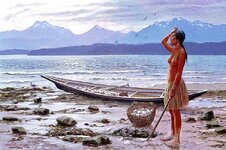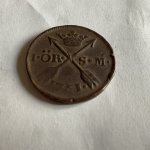Tuberale
Gold Member
Capt. James Scarborough's gold cache
While re-reading my copy of Ruby El Hult's "Treasure Hunting Northwest", I found some notes I made back in 1982 when I was spending considerable time at the Oregon Historical Society attempting to track down El Hult's original sources.
Captain James Scarborough was an in-law of Chief Comconnolly, and homesteaded on what ever since has been known as Scarborough Hill, where he built "... a large, fine house, and a smaller one behind it for his Chinook Indian wife and their two sons."
Here is my copy of the notes I made. Hope this helps someone else with their search for this fabled treasure which, apparently, was viewed by no less than 14 early pioneers. BTW, the bulk of Scarborough's treasure came from an early shipwreck inside the Columbia River mouth, also known as the "Graveyard of Ships."
"Scarborough
Mary Duchesne found a piece of gold on Scarborough Hill, about 18709. (Charles R. Eastland, Astoria, OR)
married Ann Elizabeth (daughter of Chief Concomly) in 1843 at Ft. Vancouver
Scarborough died February, 1855
on board the Isabella when it was wrecked in May 1830.
served as mate on the Beaver and Llama, for 10 years was master of the schooner Cadboro.
Scarborough had fairly good garden - fruit trees, ornamental shrubs, Mission Rose, Hawthorne tree (planted 1848 - 50' tall)
retired 1850
continued guideing ships - was 2nd recognized Columbia River Bar pilot after Chief Concomly
Also built up a fish trade with New England. Tradition says he was paid for the fish with gold slugs or ingots - supposed to have amassed $60,000.
Ann Elizabeth may have known where the cache was buried, but didn't. Superstitious? (Perhaps, but if she was, where better to hide the cache than at the Chinook's Totem?)"
The original story can be found in "Lost Mines and Treasures of the Pacific Northwest", as well as an update in "Treasure Hunting Northwest", both by Ruby El Hult.
Scarborough is alledged to have introduced a white-flowering hawthorne tree. which he apparently used as a beacon to guide ships into the Columbia River safely. He reportedly also introduced gorse, scotchbroom, and blackberry into the United States from his native Scotland. He was reportedly paid in early-day gold coins, probably recently minted in California.
Scarborough was involved in a lucrative triangle-trade route between Portland (or Seattle)-San Francisco-Honolulu. He brought the first newspapers from San Francisco detailing the finding of gold in California in 1848 to Portland. He was savvy. He didn't release the newspapers until _after_ he had bought up every tool in Portland and Oregon City that had a wooden handle, often paying double to going price. After selling the newspapers in Oregon City and Portland, he then backtracked to San Francisco with a load of fresh-milled boards, shovels, hoes, canvas, and food, for which he found a ready market at 2-10 times what he paid for them in Oregon. His was the first-known ship to travel upriver on the Willamette River to Oregon City, with several canoes filled with Indians ahead of him marking the depth of the water. Until that time, the Willamette River to Willamette Falls was considered too shallow to have a ship on.
In addition, he and a contingent of Chinook Indians salvaged from an abandoned ship in the "quicksands" of the Columbia River a chest containing 400 $50-dollar gold slugs. When the ship was salvaged is somewhat in question, but probably was between 1850 and 1855, when the captain died. The Chinooks used some of these coins as markers in a gambling game they played. The northern shore of the Columbia River has unearthed several of these coins afterwards, where they were sometimes included in Native American burials.
Scarborough was apparentlly uncertain whether the $50 gold pieces were legal money. He took them to several people to have them weighed. The results were inconclusive for Scarborough, but are quite believable today. Early $50 gold pieces from private mints (such as Moffit and Blake, Wass-Molitor, Kellogg, etc, as well as United States Assay Office of Gold) in California did not contain $50 worth of gold. Some were slightly under, many were $1 or $2 over. These were quickly melted for that exact reason: they were worth more as melt value than face value. They are extremely rare and highly sought today by collectors.
Early con-artists found another scam for the $50 gold "slugs" as they became known. When travelling in the early West, it was not uncommon to call on a farmer or rancher, and ask for a meal and lodging for the night. Most people had not seen a $50 gold slug. Fewer had change for a meal and lodging, which usually was about 50 cents to 75 cents. If a household couldn't make change for the slug, the traveller was often invited to stay for free, after claiming that was the only money they had. But if the farmer or rancher could give change, the traveller suddenly had other money to pay with.
The 400 gold slugs were found in a small chest on the ship. But there were no banks at the time, and Scarborough did not trust his sons, who had been raised by Ann Elizabeth, his Chinookian wife. One son followed Scarborough to his hiding place, and Scarborough spent the next week transferring the coins to another "secure" location, this time making sure he wasn't followed.
While re-reading my copy of Ruby El Hult's "Treasure Hunting Northwest", I found some notes I made back in 1982 when I was spending considerable time at the Oregon Historical Society attempting to track down El Hult's original sources.
Captain James Scarborough was an in-law of Chief Comconnolly, and homesteaded on what ever since has been known as Scarborough Hill, where he built "... a large, fine house, and a smaller one behind it for his Chinook Indian wife and their two sons."
Here is my copy of the notes I made. Hope this helps someone else with their search for this fabled treasure which, apparently, was viewed by no less than 14 early pioneers. BTW, the bulk of Scarborough's treasure came from an early shipwreck inside the Columbia River mouth, also known as the "Graveyard of Ships."
"Scarborough
Mary Duchesne found a piece of gold on Scarborough Hill, about 18709. (Charles R. Eastland, Astoria, OR)
married Ann Elizabeth (daughter of Chief Concomly) in 1843 at Ft. Vancouver
Scarborough died February, 1855
on board the Isabella when it was wrecked in May 1830.
served as mate on the Beaver and Llama, for 10 years was master of the schooner Cadboro.
Scarborough had fairly good garden - fruit trees, ornamental shrubs, Mission Rose, Hawthorne tree (planted 1848 - 50' tall)
retired 1850
continued guideing ships - was 2nd recognized Columbia River Bar pilot after Chief Concomly
Also built up a fish trade with New England. Tradition says he was paid for the fish with gold slugs or ingots - supposed to have amassed $60,000.
Ann Elizabeth may have known where the cache was buried, but didn't. Superstitious? (Perhaps, but if she was, where better to hide the cache than at the Chinook's Totem?)"
The original story can be found in "Lost Mines and Treasures of the Pacific Northwest", as well as an update in "Treasure Hunting Northwest", both by Ruby El Hult.
Scarborough is alledged to have introduced a white-flowering hawthorne tree. which he apparently used as a beacon to guide ships into the Columbia River safely. He reportedly also introduced gorse, scotchbroom, and blackberry into the United States from his native Scotland. He was reportedly paid in early-day gold coins, probably recently minted in California.
Scarborough was involved in a lucrative triangle-trade route between Portland (or Seattle)-San Francisco-Honolulu. He brought the first newspapers from San Francisco detailing the finding of gold in California in 1848 to Portland. He was savvy. He didn't release the newspapers until _after_ he had bought up every tool in Portland and Oregon City that had a wooden handle, often paying double to going price. After selling the newspapers in Oregon City and Portland, he then backtracked to San Francisco with a load of fresh-milled boards, shovels, hoes, canvas, and food, for which he found a ready market at 2-10 times what he paid for them in Oregon. His was the first-known ship to travel upriver on the Willamette River to Oregon City, with several canoes filled with Indians ahead of him marking the depth of the water. Until that time, the Willamette River to Willamette Falls was considered too shallow to have a ship on.
In addition, he and a contingent of Chinook Indians salvaged from an abandoned ship in the "quicksands" of the Columbia River a chest containing 400 $50-dollar gold slugs. When the ship was salvaged is somewhat in question, but probably was between 1850 and 1855, when the captain died. The Chinooks used some of these coins as markers in a gambling game they played. The northern shore of the Columbia River has unearthed several of these coins afterwards, where they were sometimes included in Native American burials.
Scarborough was apparentlly uncertain whether the $50 gold pieces were legal money. He took them to several people to have them weighed. The results were inconclusive for Scarborough, but are quite believable today. Early $50 gold pieces from private mints (such as Moffit and Blake, Wass-Molitor, Kellogg, etc, as well as United States Assay Office of Gold) in California did not contain $50 worth of gold. Some were slightly under, many were $1 or $2 over. These were quickly melted for that exact reason: they were worth more as melt value than face value. They are extremely rare and highly sought today by collectors.
Early con-artists found another scam for the $50 gold "slugs" as they became known. When travelling in the early West, it was not uncommon to call on a farmer or rancher, and ask for a meal and lodging for the night. Most people had not seen a $50 gold slug. Fewer had change for a meal and lodging, which usually was about 50 cents to 75 cents. If a household couldn't make change for the slug, the traveller was often invited to stay for free, after claiming that was the only money they had. But if the farmer or rancher could give change, the traveller suddenly had other money to pay with.
The 400 gold slugs were found in a small chest on the ship. But there were no banks at the time, and Scarborough did not trust his sons, who had been raised by Ann Elizabeth, his Chinookian wife. One son followed Scarborough to his hiding place, and Scarborough spent the next week transferring the coins to another "secure" location, this time making sure he wasn't followed.







